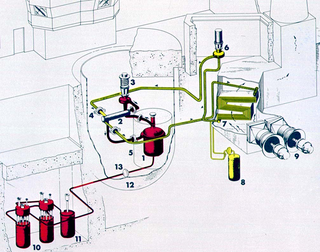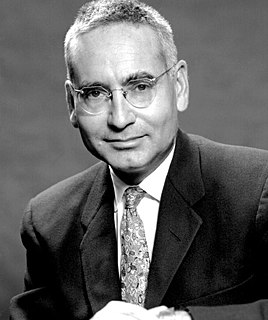Related Research Articles

A breeder reactor is a nuclear reactor that generates more fissile material than it consumes. Breeder reactors achieve this because their neutron economy is high enough to create more fissile fuel than they use, by irradiation of a fertile material, such as uranium-238 or thorium-232 that is loaded into the reactor along with fissile fuel. Breeders were at first found attractive because they made more complete use of uranium fuel than light water reactors, but interest declined after the 1960s as more uranium reserves were found, and new methods of uranium enrichment reduced fuel costs.

The Savannah River Site (SRS) is a nuclear reservation in the United States in the state of South Carolina, located on land in Aiken, Allendale, and Barnwell counties adjacent to the Savannah River, 25 miles (40 km) southeast of Augusta, Georgia. The site was built during the 1950s to refine nuclear materials for deployment in nuclear weapons. It covers 310 square miles (800 km2) and employs more than 10,000 people.

A molten salt reactor (MSR) is a class of nuclear fission reactor in which the primary nuclear reactor coolant and/or the fuel is a molten salt mixture. MSRs offer multiple advantages over conventional nuclear power plants, although for historical reasons, they have not been deployed.

Generation IV reactors are a set of nuclear reactor designs currently being researched for commercial applications by the Generation IV International Forum, with technology readiness levels varying between the level requiring a demonstration, to economical competitive implementation. They are motivated by a variety of goals including improved safety, sustainability, efficiency, and cost.

The Molten-Salt Reactor Experiment (MSRE) was an experimental molten salt reactor at the Oak Ridge National Laboratory (ORNL) researching this technology through the 1960s; constructed by 1964, it went critical in 1965 and was operated until 1969.

The program for nuclear power in Indonesia includes plans to build nuclear reactors in the country for peaceful purposes. The national legislative organ for nuclear energy, Badan Pengawas Tenaga Nuklir (BAPETEN), was founded in 1998. The national agency for atomic energy is BATAN.

Nuclear power is the fifth-largest source of electricity in India after coal, gas, hydroelectricity and wind power. As of March 2018, India has 22 nuclear reactors in operation in 7 nuclear power plants, with a total installed capacity of 6,780 MW. Nuclear power produced a total of 35 TWh and supplied 3.22% of Indian electricity in 2017. 7 more reactors are under construction with a combined generation capacity of 4,300 MW.
Peak uranium is the point in time that the maximum global uranium production rate is reached. After that peak, according to Hubbert peak theory, the rate of production enters a terminal decline. While uranium is used in nuclear weapons, its primary use is for energy generation via nuclear fission of the uranium-235 isotope in a nuclear power reactor. Each kilogram of uranium-235 fissioned releases the energy equivalent of millions of times its mass in chemical reactants, as much energy as 2700 tons of coal, but uranium-235 is only 0.7% of the mass of natural uranium. Uranium-235 is a finite non-renewable resource. There is speculation that future advances in breeder reactor technology could allow the current reserves of uranium to provide power for humanity for billions of years, thus making nuclear power a sustainable energy. However, in 2010 the International Panel on Fissile Materials said "After six decades and the expenditure of the equivalent of tens of billions of dollars, the promise of breeder reactors remains largely unfulfilled and efforts to commercialize them have been steadily cut back in most countries." But in 2016, the Russian BN-800 fast-neutron breeder reactor started producing commercially at full power.

The liquid fluoride thorium reactor is a type of molten salt reactor. LFTRs use the thorium fuel cycle with a fluoride-based, molten, liquid salt for fuel. In a typical design, the liquid is pumped between a critical core and an external heat exchanger where the heat is transferred to a nonradioactive secondary salt. The secondary salt then transfers its heat to a steam turbine or closed-cycle gas turbine.
SolarReserve is a developer of utility-scale solar power projects which include Concentrated Solar Power (CSP) and Photovoltaic (PV) technology. The company has commercialized solar thermal energy storage technology that enables solar power tower CSP plants to deliver electricity day and night. In this technology, a molten salt is used to capture the energy from the sun and store it. When electricity is needed, the stored liquid salt is used to turn water into steam to turn a turbine and generate electricity.
The FUJI molten salt reactor is a proposed molten-salt-fueled thorium fuel cycle thermal breeder reactor, using technology similar to the Oak Ridge National Laboratory's Molten Salt Reactor Experiment – liquid fluoride thorium reactor. It was being developed by the Japanese company International Thorium Energy & Molten-Salt Technology (IThEMS), together with partners from the Czech Republic. As a breeder reactor, it converts thorium into the nuclear fuel uranium-233. To achieve reasonable neutron economy, the chosen single-salt design results in significantly larger feasible size than a two-salt reactor. Like all molten salt reactors, its core is chemically inert and under low pressure, helping to prevent explosions and toxic releases. The proposed design is rated at 200 MWe output. The IThEMS consortium planned to first build a much smaller MiniFUJI 10 MWe reactor of the same design once it had secured an additional $300 million in funding.
Small modular reactors (SMRs) are a type of nuclear fission reactor which are smaller than conventional reactors, and manufactured at a plant and brought to a site to be assembled. Modular reactors allow for less on-site construction, increased containment efficiency, and heightened nuclear materials security. SMRs have been proposed as a way to bypass financial barriers that have plagued conventional nuclear reactors.

The nuclear energy programs of Venezuela started during the 1950s but currently there are no active nuclear power facilities. Most of Venezuela's nuclear science activities are carried out at Venezuelan Institute for Scientific Research (IVIC).

The Crescent Dunes Solar Energy Project is a 110 megawatt (MW) net solar thermal power project with 1.1 gigawatt-hours of energy storage, located near Tonopah, about 190 miles (310 km) northwest of Las Vegas. It substantially missed its intended 50%-efficient power production by only achieving about 20% efficiency, resulting in lawsuits and changes of control. The site has not produced power since April 2019 and its sole customer, NV Energy, subsequently terminated their contract. Bloomberg reports that NV Energy wasn’t allowed to sever its agreement with the plant until after the DoE took over the shuttered plant in August 2019.

Thorium-based nuclear power generation is fueled primarily by the nuclear fission of the isotope uranium-233 produced from the fertile element thorium. According to proponents, a thorium fuel cycle offers several potential advantages over a uranium fuel cycle—including much greater abundance of thorium on Earth, superior physical and nuclear fuel properties, and reduced nuclear waste production. However, development of thorium power has significant start-up costs. Proponents also cite the lack of easy weaponization potential as an advantage of thorium due to how difficult it is to weaponize the specific Uranium 233/232 and Plutonium 238 isotopes produced by Thorium reactors, while critics say that development of breeder reactors in general increases proliferation concerns. As of 2020, there are no operational thorium reactors in the world.

The Alvin Weinberg Foundation was a registered UK charity, operating under the name Weinberg Next Nuclear, that campaigned for research and development into next-generation nuclear energy. In particular, it advocated advancement of Liquid Fluoride Thorium Reactor (LFTR) and other Molten Salt Reactor (MSR) technologies.

The TMSR-500 is a "Thorium Molten Salt Reactor" nuclear power plant being designed for the Indonesia market by ThorCon. The TMSR-500 is based on a small modular reactor (SMR) that employs molten salt technology. The reactor design is based on the Denatured molten salt reactor (DMSR) design from Oak Ridge National Laboratory and employs liquid fuel, rather than a conventional solid fuel. The liquid contains the nuclear fuel and serves as primary coolant. ThorCon plans to manufacture the complete power plants cheaply in shipyards employing modern shipbuilding construction techniques.
Transatomic Power was an American company that designed Generation IV nuclear reactors based on molten salt reactor (MSR) technology.
Copenhagen Atomics is a Danish molten salt technology company developing mass manufacturable molten salt reactors. The company headquarters are co-located with Alfa Laval in Copenhagen.
References
- ↑ "Floating Nuke Power Plants Get Backing From Quant Investor". Bloomberg.
- ↑ "Indonesia and ThorCon to Develop Thorium MSR". International Thorium Energy Organization. Retrieved 12 January 2016.
- ↑ DOE. "GAIN Voucher Recipients 1st Round - 30 Apr 2018" (PDF).
- ↑ DOE. "Electroanalytical Sensors for Liquid Fueled Fluoride Molten Salt Reactor" (PDF).
- ↑ "PAL Indonesia, Thorcon sign deal to build $1.2 billion nuclear reactor". Reuters. July 18, 2019 – via www.reuters.com.
- ↑ "Indonesia Validates ThorCon". June 2019.
- ↑ "A Thorium Molten Salt Reactor when and Where You Need It". May 2019.